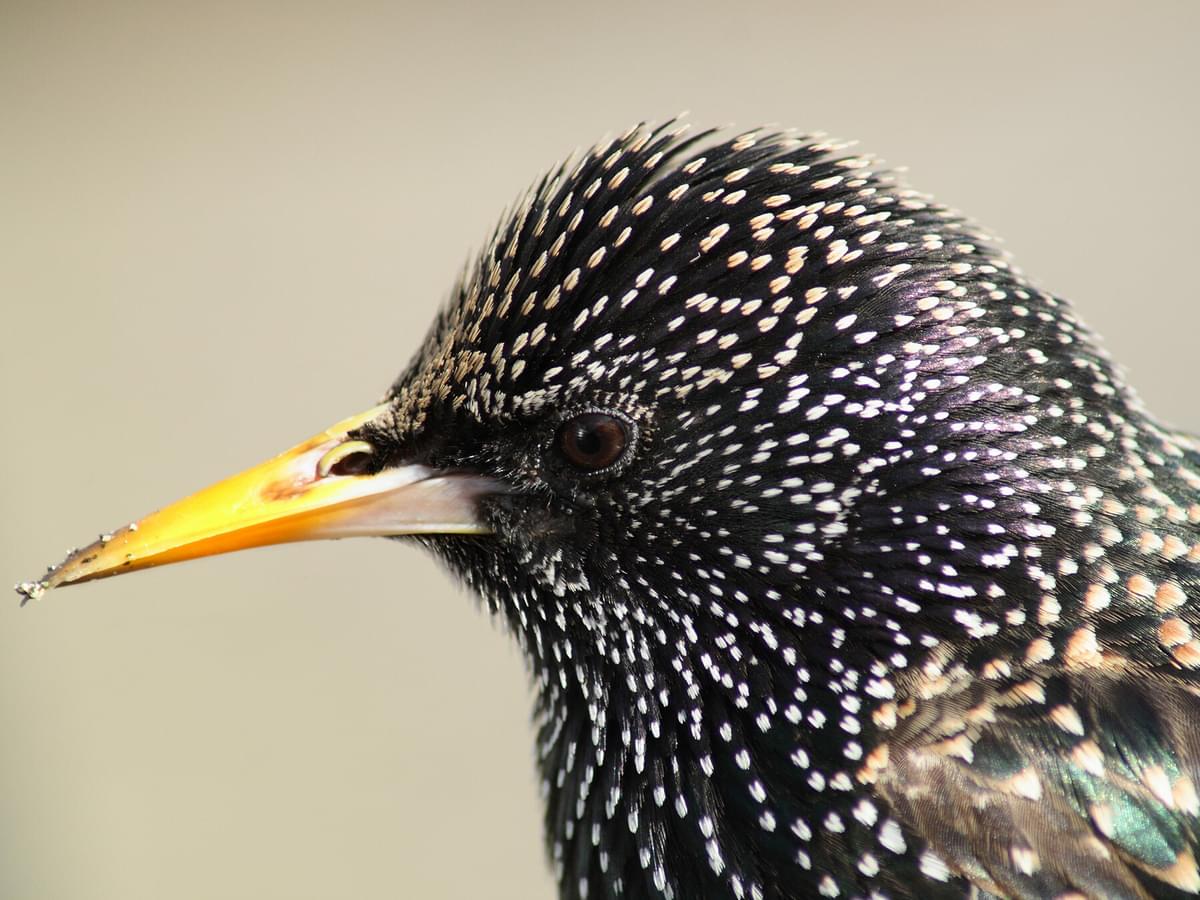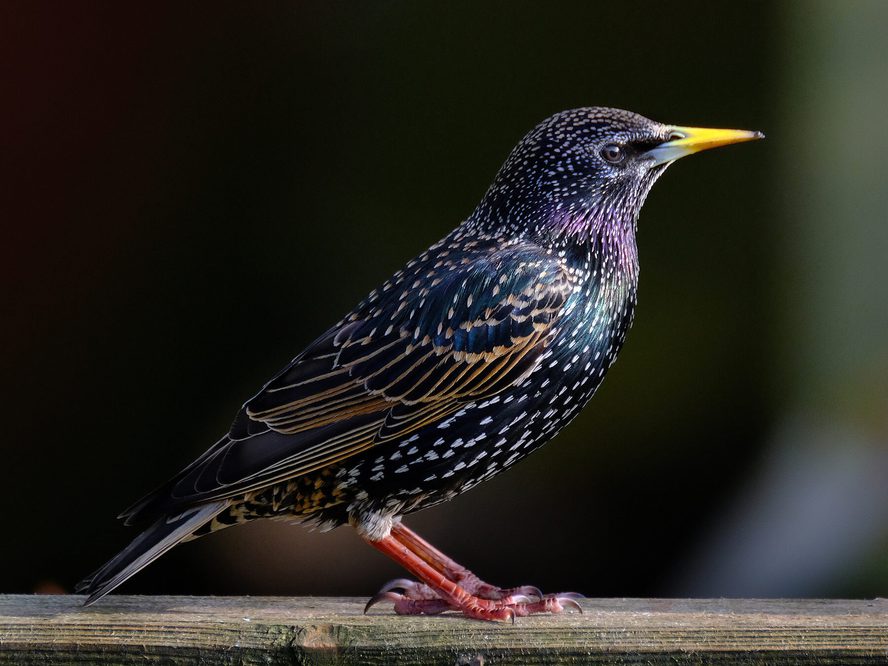Jump to Section
European Starling or Common Grackle: A Guide To Their Distinctive Features
Last updated: 18 December 2023

Key takeaways
- Physical Differences: The European Starling has dark eyes, pinkish legs, and a slender yellow bill, while the Common Grackle has yellow eyes, dark legs, and a dark bill. Grackles are larger with longer tails, sometimes as long as the bird itself, and starlings have shorter tails without patterns.
- Behavioral and Diet Variations: Grackles are native to the US, noisy, and feed on a variety of foods including crops. Starlings, not native to just the US, are generally quieter, eat insects and seeds, and travel in groups. Grackles have a more intense gaze due to their bright, golden eyes.
- Habitat and Plumage: Both species have iridescent plumage, but starlings resemble grackles more in winter with less vibrant, spotted plumage and black beaks. Grackles and starlings can occasionally flock together outside the nesting season.
- Species Distinction and Interesting Facts: Grackles belong to the Troupials and Allies family and display sexual dimorphism, with males being larger. They can recognize human faces and mimic sounds. Starlings, part of the Starling family, have spread rapidly in North America since their introduction in the 1890s and are known for their strong jaw muscles used for foraging.
There's more to discover. Continue scrolling for the full article below.
European or Common Starlings (Sturnus vulgaris) and Common Grackles (Quiscalus quiscula) at a glance look extremely similar, which means identification can be an issue. We've put together this guide to highlight the differences between the species to help you tell them apart easier.
The most obvious differences between grackles and starlings are that starlings have dark eyes, pinkish legs and a short, slender yellow bill (breeding birds), whereas the common grackle has dark legs, dark bill and yellow eyes. Grackles are also generally larger than starlings and also have longer tails.
These are the best ways to tell the two apart, although there are more reasons - which we'll go into below.

Common Grackle perched on a branch

European Starling close up
Other differences
Common Grackles are native to the US and will eat just about anything - they do, however, love to eat crops (mainly corn). The bright, golden eyes these birds have, give them an expression of intent. Grackles also tend to travel in large, noisy groups. Females are similar to males but less glossy.
European Starlings mainly eat insects and seeds, and if you've ever had them at your feeders, you'll know how quickly they can clean them out. Starlings will also travel in groups but are generally quieter when compared to the grackle - they can also be noisy. Starlings are also not native to just the United States.
When it comes down to length, grackles can reaches lengths of up to 20 inches, whereas starlings generally only reach lengths of up to 12 inches. Grackles also have longer tails than starlings, the tail of a starling is usually shorter than their bodies with no patterns or visible markings. Grackle tails are sometimes as long as the bird is tall and in flight show an orange patch.
Common Grackle Call/Song
Christopher McPherson, XC638297. Accessible at www.xeno-canto.org/638297.
Common Starling Song
Ramya, XC610872. Accessible at www.xeno-canto.org/610872.

European Starling in winter plumage
Similarities between the Common Grackle and European Starling
Both the common grackle and European starlings have a shimmering iridescent plumage. Starlings look more similar to the grackle whilst in their winter plumage, which they have black beaks, and their plumage becomes more spotted and less vibrant. The beaks are similar in length and shape, but starlings tend to have slightly longer and thinner bills.
They also tend to both flock in large groups.
Do grackles and starlings flock together?
Yes, when nesting season is over, both starlings and grackles are known to occasionally flock together. Which can make identification much more confusing.
Are Grackles and Starlings the same bird?
No, they are two different species of birds. Common Grackles are members of the Troupials and Allies family, and European Starlings are part of the Starling family.

Common Grackle perched in a tree
Interesting facts about the Common Grackle
- The Common Grackle is part of the Troupials and Allies family (Icteridae) which has 105 species of birds in it. Species in this family can be found across North America and South America. Because these birds having sharp-tipped bills that they can open strongly, it gives them the ability to stab and pry off the bark of trees or to open up soft fruit.
- Male and female grackles can generally be distinguished by the size of their bodies. This is because they possess sexual dimorphism - which is found in many species of birds, where the female is generally smaller than the male.
- When humans are close to their nests, grackles use alarm calls to alert other birds of the threat.
- Just like crows and ravens, grackles have the ability to recognise and remember individual faces of human beings. They can also mimic the sounds of other species of birds and occasionally even humans.
- Unlike other birds that hop whilst on the ground, grackles prefer to walk.
- You're much more likely to see a female common grackle than a male. This is because the grackle population is much more abundant with females, as their life expectancy is greater than the male as they require less food.

European Starling on the ground
Interesting facts about the European Starling
- It is thought that around 100 starlings were released into Central Park, in New York City in 1890 and 1891. This makes the success of the European Starling incredible really, as there now is thought to be over 200 million of these birds across North America. The population now spread across the majority of the continent, derived from those few birds.
- Worldwide, there are 123 species in the starling family (Sturnidae). There is a tremendous variety that can be found across Asia and Africa. The most common bird in this family is the European Starling.
- If a few crucial needs are met, European Starlings inhabit a vast variety of habitats. Mostly, you'll see starlings foraging on short lawns and fields in urban areas. During non-breeding, starlings explore different habitats like salt marshes, orchards, refuse dumps, moorland and tidal flats.
- Starlings will roost in trees, reedbeds and even buildings in town centres. In Europe, winter roosts can reach over one million birds. In Israel, there was a reported 5 to 8 million birds in one single roost!
- Starlings have strong jaw muscles, which is used to pierce their beaks into the soil for insects. They will occasionally also catch flies in the air.
- Starlings have the tendency to destroy the nest of other birds from time to time, which causes concern for bird authorities around the world. This is because it can cause a decline on native birds around the world.









